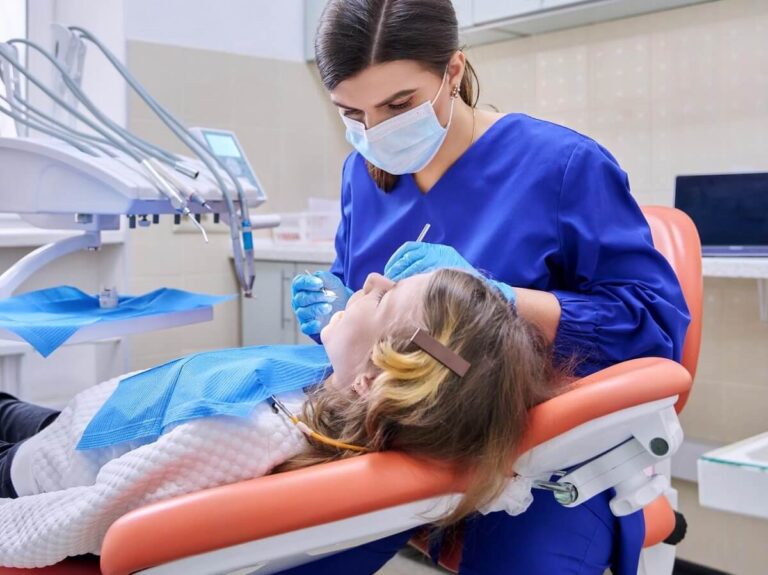Keeping your teeth in good condition is essential for your overall health and wellbeing. Understanding the anatomy of your teeth will help you to better care for them and keep them strong. In this article, we will explore the different parts of a tooth and how they work together to create healthy smiles. We’ll look at enamel, dentin, pulp, cementum and more – all of which play an important role in keeping our teeth healthy. With this knowledge, you’ll be able to make informed decisions about dental hygiene and treatment plans that are tailored to your individual needs.
Parts of Your Teeth
Enamel – the hardest substance in the body that acts as a protective layer against decay.
Dentin – the layer beneath the enamel that helps to give teeth their shape and strength.
Cementum – the layer that helps to attach the tooth to the gums and jawbone.
Pulp – the softer inter structure of the teeth that contains blood vessels and nerves that keep the tooth alive.
Periodontal Ligament – specialized connective tissue that attaches the teeth to the bone and provides support for them.
A normal adult mouth has 32 teeth, including wisdom teeth.
Incisors – they are located at the front of the mouth and have a sharp, chisel-like shape that helps them to cut food into small pieces. Incisors are essential for biting and chewing food, as well as speaking clearly.
Canines – these are located at the four corners of our mouth and have a sharp point that helps us to bite into food. They also help to hold food in place while we chew, as well as assist in speech articulation.
Premolars – these are also known as bicuspids and are a set of teeth located between the molars and the canines. They are essential for proper chewing and grinding of food. Premolars have two cusps that help to grind and crush food to make it easier to swallow.
Molars – they are the largest teeth in the mouth and are located at the back of the jaw. They have a flat surface with several ridges and grooves that help to grind food into smaller pieces for easier digestion.
Wisdom Teeth – these are the third and final set of molars that typically erupt between the ages of 17 and 25. They are located in the very back of the mouth, making them difficult to clean and often leading to oral health issues such as cavities, gum disease, and infection. Despite their name, wisdom teeth can actually cause more harm than good if not removed in time.
Teeth Conditions
Cavities – these are a common dental problem that can cause pain, discomfort, and even tooth loss if left untreated. Cavities occur when bacteria in the mouth breaks down the enamel on the surface of the tooth, leading to decay.
Tooth Decay – the is a common dental issue that affects people of all ages. It occurs when bacteria in the mouth break down the enamel on teeth, leading to cavities and other forms of damage. If left untreated, tooth decay can lead to serious health problems including pain, infection, and even tooth loss.
Periodontitis – this is an inflammatory disease of the gums and other structures that support the teeth. It is caused by bacteria that accumulate on the teeth and gums, leading to infection and inflammation. If left untreated, periodontitis can cause tooth loss, gum recession, and other serious oral health problems.
Gingivitis – this is an inflammatory condition of the gums that can lead to serious oral health problems if left untreated. It is caused by bacteria in the mouth, which can build up in the form of plaque and tartar and irritate the gums, leading to redness, swelling, and bleeding. Gingivitis is a very common condition and can be treated with proper oral hygiene habits such as regular brushing and flossing.
Plaque – this is a sticky, colorless deposit that accumulates on the surface of teeth and gums. It is composed of bacteria, food particles, and saliva that can cause cavities and gum disease if left unchecked. Plaque can also lead to bad breath and discoloration of the teeth.
Tartar – this is a hard, calcified substance that forms on the teeth over time. It can cause tooth decay and gum disease if left untreated. Fortunately, there are several ways to remove tartar and keep your teeth healthy. Regular brushing and flossing, along with regular visits to the dentist, are essential for preventing tartar buildup.
Teeth Grinding – Teeth grinding, also known as bruxism, is a common problem among children and adults. It is a condition where people grind their teeth or clench their jaws during sleep or when they are awake. Teeth grinding can cause serious damage to the teeth and jaw, leading to pain and discomfort. It can also lead to emotional problems such as anxiety and depression. Therefore, it is important to identify the causes of teeth grinding so that proper treatment can be provided.
Tooth Sensitivity – this is a common problem that can cause pain and discomfort when eating or drinking cold, hot, sweet, or acidic foods. It’s caused by the exposure of the dentin layer of your tooth to external stimuli. To reduce tooth sensitivity, it’s important to understand the causes and treatments available.
Overbite – this is a common dental condition that affects many people. It occurs when the upper teeth overlap the lower teeth too much, causing discomfort and pain. In some cases, it can even lead to speech problems and difficulty in eating. Fortunately, there are several treatments available to help patients with overbite. From braces and retainers to surgery, these treatments can help correct the alignment of the teeth and jaw for a more comfortable life.
Underbite – this is a dental condition in which the lower jaw protrudes past the upper jaw, resulting in misaligned teeth and an uneven bite. It can be caused by genetics, trauma, or poor oral hygiene habits. In severe cases, an underbite can cause speech impediments, difficulty chewing or swallowing food, and even facial deformity. Fortunately, there are treatments available to correct an underbite and restore your smile.
Now that you are better informed about your teeth, consult with your dentist about any dental concerns you may have.
Sun City Dental
11240 Montwood Dr Ste J
El Paso, TX 79936
915-201-2539

Sun City Dental
8611 N. Loop Dr.
El Paso, TX 79907
915-859-2690
Disclaimer: Every effort has been made to ensure the accuracy of this article and other articles on this website at the time it was written. The information contained in this blog post is not intended to be a substitute for proper dental care as recommend by your trained dentist. We are not responsible for any of the results you experience while applying the information contained on the smilesuncitydental.com website. It is our sincere desire to continue to provide quality information as it relates to dental matters covered in this website and it is our aim to provide accurate information as it relates to your dental care.


